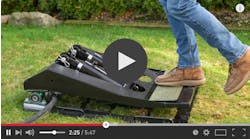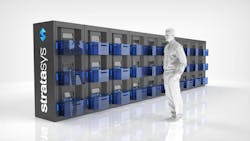Download this article in PDF format.
Anyone keeping up with 3D printing will probably say it’s great for prototyping and some end-use parts. But when the amount of parts reaches a certain number, the return on investment (ROI) starts to move toward more traditional processes, such as injection molding. Some companies have been increasing this number over time. Recently, Formlabs and Stratasys each released new machines that will automate the entire 3D-printing process. These companies are increasing the ROI of 3D printing and capturing more market share from traditional processes.
It is important to point out the benefits of accelerating 3D printing. For manufacturers, this means gaining the ability to:
- Make faster iterations or modifications to prototypes and/or parts.
- Do lightweighting; 3D printing allows the ability to change the fill of parts from almost fully dense, to no fill at all.
- Produce complex geometries that aren’t possible in other processes.
- Open new revenue streams by offering customization.
Some of the ways companies are making this happen include:
- Combining multiple parts into one to reduce or eliminate assembly time.
- Nesting parts—if it’s possible with the process.
- Reducing or changing fill or reducing fill tolerances so that the printer will print faster on the areas where tolerance isn’t a concern
- Reducing post-processing by eliminating support structures or having support structures dissolve away easily.
- Through automation, which is the focus of this article.
Some companies, such as Boeing, Sikorsky, Airbus, and Ford, are already using 3D printing in a way that can be considered mass production. Next year, for example, Airbus plans on producing 30 tons of 3D-printed parts a month. However, these are Tier One manufacturers, and often the parts are high-end, high-cost parts. Many of these manufacturers are also in transportation, where reducing weight is imperative. But what about regular low-cost parts, which aren’t so constrained by weight?
The LEAP engine from GE will have 19 3D-printed fuel nozzles. Multiple parts are 3D-printed, such as the housing for the T25 sensor that provides pressure and temperature measurements for the engine’s control system (Courtesy of CFM International).
Fused Deposition Modeling
Stratasys has experience in manufacturing cost-effective parts, and recently teamed up with Desktop Metal to launch the Demonstrator. This is a stack of three scalable, fused-deposition-modeling (FDM) printers, one on top of the other. They print continuously by using a film of plastic that sits on top of the print bed. When a part is finished, the film slides the part out of the printer. The film is then cut, leaving a new sheet covering the print bed, and the finished part falls into a bin.
The Stratasys Demonstrator helps increase print capacity for 3D printers. Each printer is able to communicate in real time. This machine doesn’t have to stop between parts or between jobs. The FDM also eliminates some processes, like curing, which is needed for SLA parts.
“With the nine machines we have, we can produce 1,500 parts per day,” says Mark Neilson, CEO of In’Tech.
If you need to increase production, it’s simple to expand by adding more stacks. With the software, multiple jobs print can in parallel without downtime, there are no tooling changeovers, and the inventory supply chain is nearly non-existent.
“In the past, we would typically switch from 3D printing to injection molding when an order hit 300 to 400 parts. With the Continuous Build 3D Demonstrator, that number goes way up to around 1,500 to 2,000 parts” says Rich Stump, principal and co-founder of FATHOM. “The Demonstrator allows customers to reap the time and cost benefits of repeatable and constant 3D printing. Along with the advantages of an iterative design process and free complexity, the Demonstrator makes additive a serious contender pricewise with injection molding for low-volume and bridge-to-production runs.”
While increased automation is letting 3D printing compete with injection molding on larger orders, there are limitations such as:
- The FDM process has a rougher surface finish compared to injection molding.
- Material limitation: If you need something such as ABS, you’re fine, but anything that would require certification isn’t currently supported.
- It will be increasingly difficult to find a ROI on orders over 1,500 to 2,000 parts.
SLA
Fortunately, there are more options than the Demonstrator. FDM may not be known for its surface finish, though post processing is possible, but stereolithography (SLA) can provide a higher resolution, resulting in a better surface finish. While this process also has its own challenges in materials and large orders, it has been successfully used on showroom pieces where the surface finishes are critical.
Formlabs, a leader in SLA, launched Form 1 in 2012. This printer was able to find some parts that could be produced into the thousands before injection molding would yield a higher ROI. For example, a coupling for a stepper motor was able to fit more than 400 of them in the build space of the Form 1. That allowed the ROI turning point to be as high as 11,000 parts. For more details, check out this video:
Taking in everything into account--material, labor, post-processing—Formlabs estimated that the turning point in ROI to use a traditional process was about 28 prints for this example.
That was 2012. In 2015, Form 2 was released. There wasn’t a case study on the ROI between the Form 2 and traditional processes. However, they did do a comparison of the Form 2 and just-released Form Cell. “The Form 2 is the most sold professional 3D-print engine, so this was the perfect printer to use in the Form Cell,” says Maxim Lobovsky, CEO of Formlabs. The Form Cell combines:
- One or more Form 2 stations
- One wash station
- One cure station
- Industrial gantry
In one example in which the Form 2 was printing a prosthetic, it cost about $52.30 per hand (about 16 parts). This included equipment ownership, materials, and manual labor. When the hand was printed in the Form Cell, cost was reduced by 41% (see the video above). Most of the cost was labor-related, but the cost of ownership dropped. By using the printer 90% to 95% of the time compared to maybe 30% when a worker is able to swap out trays, you’re increasing production and reducing the cost of ownership per part simply by boosting production.
Just released, the Form Cell already uses software to reduce support materials. However, unlike the FDM process, SLA is able to nest, or stack, parts.
3D Systems is another company planning to join the “increased-throughput” trend. Its platform, called the Figure 4, isn’t out just yet. According to the company, however, it will produce more parts with fewer printers. Jacqueline Troutman, senior content and communications manager at 3D Systems, expects the Figure 4 to reduce part cost by approximately 30% when compared to traditional SLA.
The key for 3D printing mirrors what we’ve seen across manufacturing for years: automation. For example, the Form Cell not only loads and unloads parts, but post-processes them. An automated arm will remove the part and place it into the washer to remove support materials. It will then move the cleaned part into the curing station. The Form 2 is already an advanced plug-and-play printer offered for under $5K. In addition, Formlabs has sophisticated software that reduces support material. This also reduces post-processing.
What’s Coming Next?
By taking advantage of some of these new processes, companies may find new revenue streams. For example, SLA is known for having materials that work well in medical applications, such as hearing aids, dental surgery guides, and prosthetics. This can expand manufacturing operations by being able to quickly produce custom tooling and/or parts in automotive, medical, and manufacturing industries. The question is: Where will technology move next?
“Moore’s Law is about predicting the future,” says David Lakatos, Formlabs chief product officer. “If you understand how the cost per part will go down, you will be able to understand what industries and applications will be impacted next.” As 3D printers become faster and engineers find new ways to design parts for 3D printing, it will certainly increase the number that signals the break-even point between new and traditional processes.















